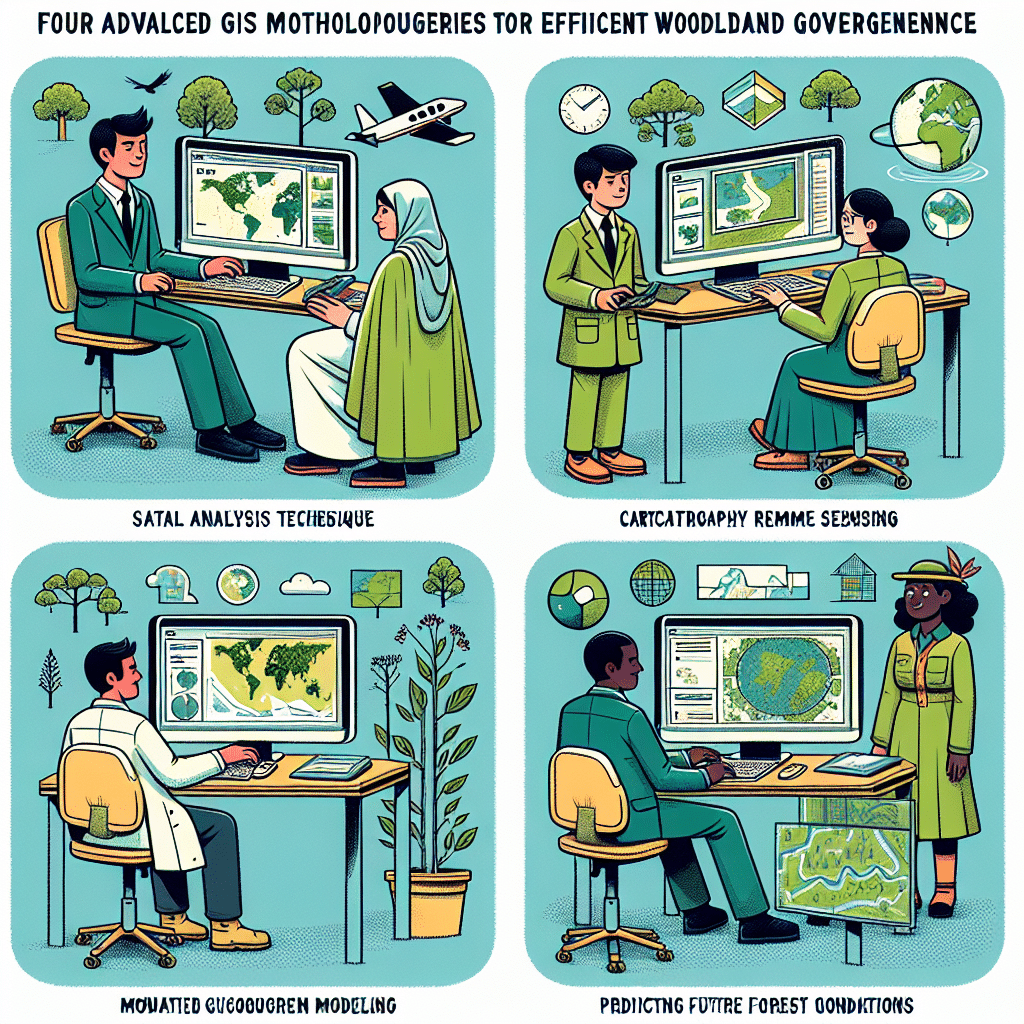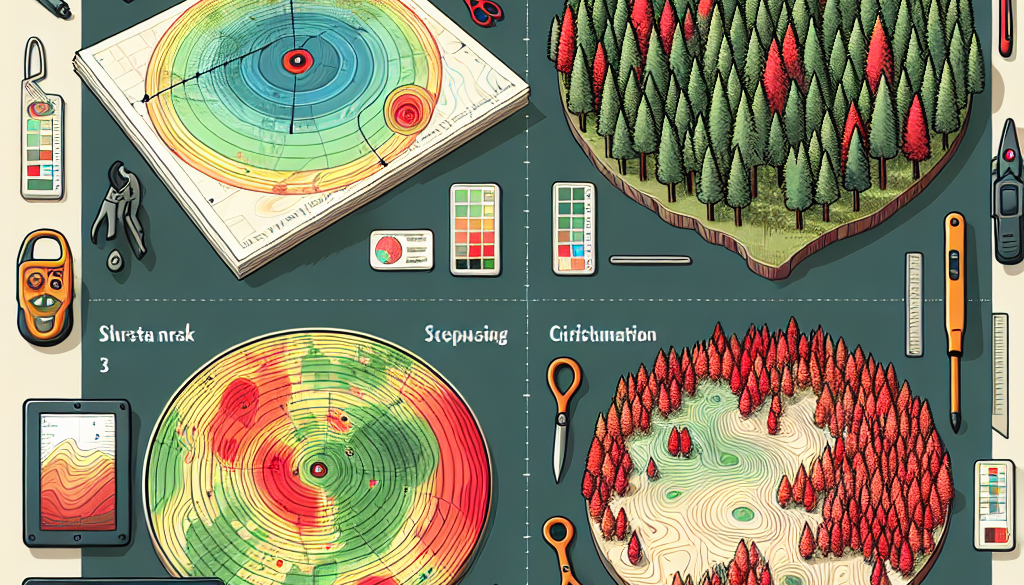Four Regular GIS techniques for powerful Forest management
-
Table of Contents
GIS Techniques for Effective Forest Management: A Guide

Forests are vital to our planet’s health, providing oxygen, absorbing carbon dioxide, and offering habitat to countless species. However, managing these complex ecosystems requires sophisticated tools and techniques. Geographic Information Systems (GIS) have become indispensable in modern forest management, offering powerful ways to collect, analyze, and visualize data. In this article, we will explore four regular GIS techniques that are transforming the way we manage our forests.
1. Remote Sensing for Forest Monitoring
Remote sensing is a key GIS technique that involves collecting data from a distance, typically using satellites or aircraft. This technology allows for the monitoring of large forest areas, providing valuable insights into forest health, composition, and changes over time.
- Change Detection: By comparing satellite images taken at different times, forest managers can identify areas of deforestation, afforestation, or reforestation.
- Vegetation Health Analysis: Using indices like NDVI (Normalized Difference Vegetation Index), remote sensing can assess the health and vigor of forest vegetation.
- Fire Assessment: Remote sensing is crucial for detecting forest fires and assessing the damage post-fire, enabling more effective response strategies.
According to a study published in the International Journal of Applied Earth Observation and Geoinformation, remote sensing techniques have been instrumental in improving the accuracy of forest cover maps, with some regions achieving over 90% accuracy.
2. Spatial Analysis for Habitat Conservation
Spatial analysis uses mathematical techniques to study entities using their topological, geometric, or geographic properties. In forest management, it’s used for:
- Species Distribution Modeling: GIS can predict the distribution of plant and animal species within a forest, which is crucial for conservation planning.
- Fragmentation Analysis: This technique assesses the effects of habitat fragmentation, helping to maintain biodiversity by identifying critical areas for protection.
- Connectivity Analysis: GIS helps in planning ecological corridors that connect fragmented habitats, ensuring wildlife movement and gene flow.
A study in the journal Biological Conservation highlighted that spatial analysis in GIS has been pivotal in identifying priority conservation areas, leading to more targeted and effective conservation efforts.
3. Inventory and Resource Management
Forest inventories are critical for sustainable management, and GIS provides a robust framework for conducting them. GIS techniques in resource management include:
- Tree Mapping: Individual trees can be mapped, providing data on species, size, and health, which is essential for timber management and biodiversity conservation.
- Resource Allocation: GIS helps in planning the sustainable extraction of resources, such as timber or non-timber forest products, minimizing environmental impact.
- Reforestation Planning: By identifying areas with declining tree cover, GIS can guide reforestation efforts to areas where they are most needed.
According to the Food and Agriculture Organization of the United Nations, the use of GIS in forest inventories has significantly increased the efficiency and accuracy of data collection, leading to better-informed management decisions.
4. Disaster Management and Mitigation
Forests are susceptible to natural disasters such as fires, storms, and insect outbreaks. GIS plays a crucial role in managing these events:
- Risk Assessment: GIS can analyze terrain, weather patterns, and forest conditions to predict and map areas at high risk of natural disasters.
- Disaster Response: During a disaster, GIS is used for real-time monitoring and coordination of response efforts, ensuring resources are deployed effectively.
- Post-Disaster Recovery: After a disaster, GIS aids in assessing damage and planning recovery efforts, such as reforestation and habitat restoration.
A report by the United States Forest Service indicates that GIS-based risk assessment models have been instrumental in reducing the impact of forest fires by informing pre-fire management strategies.
Conclusion
GIS techniques are revolutionizing forest management by providing detailed, accurate, and timely information. Remote sensing, spatial analysis, inventory and resource management, and disaster management are four key GIS techniques that enable more powerful and effective forest management. By leveraging these tools, forest managers can make informed decisions that balance ecological integrity with human needs, ensuring the sustainability of these critical ecosystems for generations to come.
Enhance Your Health with ETprotein’s Premium Protein Products
After exploring the importance of forest management, it’s clear that sustainability and health go hand in hand. ETprotein understands this connection and offers a range of high-quality protein products that support both your health and the environment. Whether you’re looking for organic rice protein, clear pea protein, or L-(+)-Ergothioneine for various applications, ETprotein has you covered with their non-GMO, allergen-free, and high-purity products. Enhance your diet with ETprotein’s sustainable protein solutions today.
About ETprotein:
ETprotein, a reputable protein and L-(+)-Ergothioneine (EGT) Chinese factory manufacturer and supplier, is renowned for producing, stocking, exporting, and delivering the highest quality organic bulk vegan proteins and L-(+)-Ergothioneine. They include Organic rice protein, clear rice protein, pea protein, clear pea protein, watermelon seed protein, pumpkin seed protein, sunflower seed protein, mung bean protein, peanut protein, and L-(+)-Ergothioneine EGT Pharmaceutical grade, L-(+)-Ergothioneine EGT food grade, L-(+)-Ergothioneine EGT cosmetic grade, L-(+)-Ergothioneine EGT reference grade and L-(+)-Ergothioneine EGT standard. Their offerings, characterized by a neutral taste, non-GMO, allergen-free attributes, with L-(+)-Ergothioneine purity over 98%, 99%, cater to a diverse range of industries. They serve nutraceutical, pharmaceutical, cosmeceutical, veterinary, as well as food and beverage finished product distributors, traders, and manufacturers across Europe, USA, Canada, Australia, Thailand, Japan, Korea, Brazil, and Chile, among others.
ETprotein specialization includes exporting and delivering tailor-made protein powder and finished nutritional supplements. Their extensive product range covers sectors like Food and Beverage, Sports Nutrition, Weight Management, Dietary Supplements, Health and Wellness Products, and Infant Formula, ensuring comprehensive solutions to meet all your protein needs.
As a trusted company by leading global food and beverage brands and Fortune 500 companies, ETprotein reinforces China’s reputation in the global arena. For more information or to sample their products, please contact them and email sales(at)ETprotein.com today.












